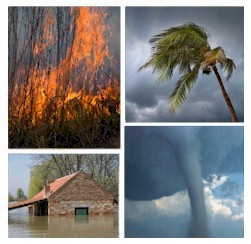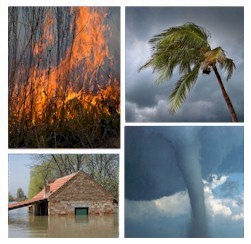|
|


Emergency Notification Systems
 This section of our technical library presents articles written about Emergency Alert Systems and Disaster Recovery definitions, terms and related information.
This section of our technical library presents articles written about Emergency Alert Systems and Disaster Recovery definitions, terms and related information.
The 911Broadcast emergency notification and alert service can deliver a large number of phone calls using a network of phone systems employing digital phone lines simultaneously. Should a disaster such as a snow storm, wild fire or flood hit your area, 911Broadcast systems can alert your community quickly providing specific instructions if an evacuation is required.
This service is available using our emergency broadcasting systems. If a dangerous chemical spill occurs in your community, you can target specific areas to call. If a severe snow storm hits your area, your community can be notified of school closings or event cancellations.
Contact DSC Today for a FREE analysis and quote and to learn more about our emergency notification systems and services.
EAS - Emergency Alert System
Emergency Alert System
The Emergency Alert System (EAS), is a national system in the U.S. put into place in 1997, superseding the Emergency Broadcast System and administered by the Federal Communications Commission (FCC). The EAS covers both radio and television (including low-power stations), and cable television companies.
EAS messages are handled by specialized equipment called EAS encoder-decoders, or endecs. The decoder component receives and interprets EAS messages from at least two state-assigned stations, and the encoder component transmits relayed messages. Low-power stations are only required to have the decoder components, but all other stations must have both decoder and encoder components.
Technical concept
 In the EAS system, messages are originated in four parts. The first part is the SAME header code, the most critical part of the EAS design. It is repeated three times, so that decoders can pick "best two out of three" for each byte, thereby eliminating most errors which can cause an activation to fail. The header code contains information about who originated the alert (President, state or local authorities, the National Weather Service, or the broadcaster), what the event is (tornado, flood, nuclear), the areas affected (up to 32 counties or states), how long the alert is valid for, the exact UTC time it was issued, and the identification of the station or other entity. (See SAME for a complete breakdown of the header.)
In the EAS system, messages are originated in four parts. The first part is the SAME header code, the most critical part of the EAS design. It is repeated three times, so that decoders can pick "best two out of three" for each byte, thereby eliminating most errors which can cause an activation to fail. The header code contains information about who originated the alert (President, state or local authorities, the National Weather Service, or the broadcaster), what the event is (tornado, flood, nuclear), the areas affected (up to 32 counties or states), how long the alert is valid for, the exact UTC time it was issued, and the identification of the station or other entity. (See SAME for a complete breakdown of the header.)
Each station must have installed an EAS decoder which then interprets these data bursts. Two of the three bursts must be found to be identical by the decoder for the message to be valid. The decoder then decides, based on its pre-programming, whether to ignore the message as not pertaining to the local area, or whether to relay it on the air. All EAN and EAT messages must be relayed immediately, and all required weekly and monthly tests (RWT and RMT) within 60 (formerly 15) minutes. For reliability, every station must monitor at least two other source stations, one of which must be designated a local primary.
The SAME header bursts are followed by an eight-second alert tone that carries no information. The tone, a combination of 853 Hz and 960 Hz sine wave tones, is the same combination of two tones that the old Emergency Broadcast System used as its attention signal, shortened from the 20 seconds formerly required to activate the EBS. Like the old EBS, this tone is in turn followed by a voice message giving details of the alert.
The message is ended by three bursts of the AFSK "EOM", or end of message, which is the text NNNN, preceded each time by the binary 10101011 calibration.
All EAS equipment must be tested weekly. The RWT, or required weekly test, consists only of the three AFSK header bursts and the three AFSK EOM bursts with no voice, and are essentially internal tests of the system components. Required monthly tests (RMT) are transmitted with all four parts, with the voice (and text on TV) stating that it is only a test. The RMT must be transmitted in the daytime and at night in alternating months.
The number of events in the national system has recently grown by several increments, and is now forty-nine events. At first, they were almost all weather events with only one to three possible categories for civil emergencies, but several classes of non-weather emergencies have now been added. In most states, the AMBER Alert System, for child abduction emergencies, has now been added as well.
Stations are required by law to keep full logs of all received and transmitted EAS messages, usually accomplished by a small receipt printer in the endec unit. Logs may also be kept electronically inside the unit, as long as there is access to an external printer, sometimes via transfer to a personal computer.
In 2004, the FCC issued a Notice of Proposed Rulemaking seeking comment on whether EAS in its present form is the most effective mechanism for warning the American public of an emergency and, if not, on how EAS can be improved.
EAS for consumers
EAS is designed to be useful for the entire public, not just those with SAME-capable equipment. However, several consumer-level radios do exist, especially weatheradio receivers, which are available to the public through both mail-order and retailers like Radio Shack, Circuit City, Best Buy, and several others. Other specialty receivers for FM radio are available only through mail-order, or in some places from federal, state, or local governments, especially where there is a potential hazard nearby such as a nuclear plant or chemical factory. These radios come pre-tuned to a station in each area that has agreed to provide this service to local emergency management officials and agencies, often with a direct link back to the plant's safety system or control room for instant activation should an evacuation or other emergency arise.
The ability to narrow messages down so that only the actual area in danger is alerted is extremely helpful in preventing false warnings, which was previously a major tune-out factor. Instead of sounding for all warnings within a station's area, SAME-decoder radios now sound only for the counties they are programmed for. When the alarm sounds, anyone with the radio knows that the danger is nearby and protective action should be taken. For this reason, the goal of the National Weather Service is that each home should have both a smoke detector and a SAME weatheradio.
Incidents
Several state officials including New York Governor George Pataki, former New York City Mayor Rudolph W. Giuliani and U.S. Congressmen and Senators have questioned members of the FCC on why the Emergency Alert System was not implemented nationwide on radio and television stations during the September 11, 2001 Terrorist Attacks where official government information is/was suppose to be distributed in place of local/network programming or newscasts.
On February 1, 2005 at 2:10pm Eastern Standard Time an employee with the Connecticut Office of Emergency Management inadvertently activated an EAS message over radio and television stations telling residents to evacuate the state immediately. At 3:45pm officials at the OEM announced that the activation and broadcast of the Emergency Alert System was in error due to the fact that the button used to conduct weekly EAS tests is located next to a button that is used to issue an emergency alert to evacuate the state, OEM officials indicated that they plan to remove the evacuation button because there is no reason whatsoever for this button to even exist.
Emergency Alert System (EAS) Phone Dialer
 With our emergency alert phone system, you can broadcast warning messages to thousands of households warning of potential catastrophic disasters including severe weather warnings.
Pre-recorded warning messages can be played giving households travel warnings, advising them where to seek shelter, or providing other safety instructions. You can send a broadcast warning to specific neighborhoods or communities in the event of a wildfire or severe weather warnings. Calls can be directed to operators that are standing by to handle special individual emergencies.
Messages can also be broadcast seeking volunteers or special assistance from emergency personnel.
With our emergency alert phone system, you can broadcast warning messages to thousands of households warning of potential catastrophic disasters including severe weather warnings.
Pre-recorded warning messages can be played giving households travel warnings, advising them where to seek shelter, or providing other safety instructions. You can send a broadcast warning to specific neighborhoods or communities in the event of a wildfire or severe weather warnings. Calls can be directed to operators that are standing by to handle special individual emergencies.
Messages can also be broadcast seeking volunteers or special assistance from emergency personnel.
Communities can be notified of other situations such as power or utility outages.
Remote communities have used this technology to warn residents when the forest service planned a controlled burn, preventing a rash of 911 and emergency calls by concerned citizens.
Other applications include warning residents when there is a toxic chemical spill or other dangerous environmental disaster.
Emergency alert messages sent to households in this fashion can be simple warnings with specific or general instructions. If the community needs feedback from the call, an interactive voice response menu can be programmed into the message allowing the person to either acknowledge the call or to contact someone. Emergency messages can vary based upon proximity to the event, with different degrees of broadcast warning and instructions.
To view how other organizations are using this phone application, please visit our Phone Warning Applications web page.
An example of an emergency alert message that you can play to your community can be heard by clicking on this Emergency Alert Message button.
Contact DSC for a FREE analysis and quote and to learn more about our emergency alert service and systems.
|




 This section of our technical library presents articles written about Emergency Alert Systems and Disaster Recovery definitions, terms and related information.
This section of our technical library presents articles written about Emergency Alert Systems and Disaster Recovery definitions, terms and related information.
 In the EAS system, messages are originated in four parts. The first part is the SAME header code, the most critical part of the EAS design. It is repeated three times, so that decoders can pick "best two out of three" for each byte, thereby eliminating most errors which can cause an activation to fail. The header code contains information about who originated the alert (President, state or local authorities, the National Weather Service, or the broadcaster), what the event is (tornado, flood, nuclear), the areas affected (up to 32 counties or states), how long the alert is valid for, the exact UTC time it was issued, and the identification of the station or other entity. (See SAME for a complete breakdown of the header.)
In the EAS system, messages are originated in four parts. The first part is the SAME header code, the most critical part of the EAS design. It is repeated three times, so that decoders can pick "best two out of three" for each byte, thereby eliminating most errors which can cause an activation to fail. The header code contains information about who originated the alert (President, state or local authorities, the National Weather Service, or the broadcaster), what the event is (tornado, flood, nuclear), the areas affected (up to 32 counties or states), how long the alert is valid for, the exact UTC time it was issued, and the identification of the station or other entity. (See SAME for a complete breakdown of the header.)
 With our emergency alert phone system, you can broadcast warning messages to thousands of households warning of potential catastrophic disasters including severe weather warnings.
Pre-recorded warning messages can be played giving households travel warnings, advising them where to seek shelter, or providing other safety instructions. You can send a broadcast warning to specific neighborhoods or communities in the event of a wildfire or severe weather warnings. Calls can be directed to operators that are standing by to handle special individual emergencies.
Messages can also be broadcast seeking volunteers or special assistance from emergency personnel.
With our emergency alert phone system, you can broadcast warning messages to thousands of households warning of potential catastrophic disasters including severe weather warnings.
Pre-recorded warning messages can be played giving households travel warnings, advising them where to seek shelter, or providing other safety instructions. You can send a broadcast warning to specific neighborhoods or communities in the event of a wildfire or severe weather warnings. Calls can be directed to operators that are standing by to handle special individual emergencies.
Messages can also be broadcast seeking volunteers or special assistance from emergency personnel.